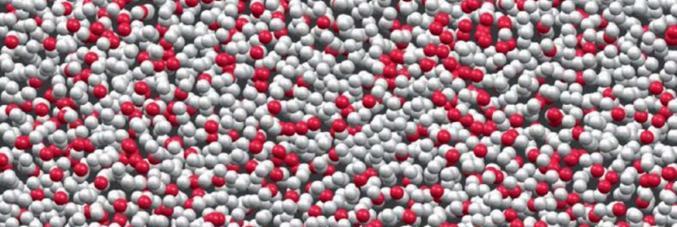
Supercooled states of liquid show a mosaic structure
02.04.2021
The study entitled Experimental evidence of mosaic structure in strongly supercooled molecular liquid, was conducted by an international research team composed of the Universities of Amsterdam, Padua, Pisa, and Barcelona with contributions from the European Synchrotron Radiation Facility of Grenoble and the Kurchatov Institute of the Moscow National Research Center, confirms the molecular dynamics of a liquid moving toward a glass-transition state is due to X-rays.
Glass can be thought of as a liquid that is no longer able to flow. When a liquid is cooled below its melting temperature, known as the undercooled stage, the molecular motion slows down such a point that the liquid appears to be frozen when observed, hence becoming a glass. Although glass is used in countless technological applications, it remains to be clear what microscopic mechanism underlies its formation. One way to understand what happens to the glass transition is to study the molecular in motion, called relaxation processes, through which a liquid can restore equilibrium following an external perturbation.
With respect to density fluctuation in liquids that are above the melting temperature, such as room temperature water, the structure changes and relaxes back to its equilibrium over a period of a few picoseconds (one millionth of one millionth of a second). With respect to liquids near the glass state the local structure changes on a time scale of the order of 100 seconds. This structural relaxation is, however, anticipated by the appearance of a faster dynamic process of molecular re-arrangements known as the Johari-Goldstein relaxation, and whose role in the glass transition is still well debated.
The international research team used time-domain X-ray interferometry of the European Synchrotron Radiation Facility’s (ESRF) nuclear resonance beamline, to study the preliminary characterization of the atomic scaled samples from Pisa (CISUP Instrumentation Network) of the Johari-Goldstein relaxation in the glass-forming liquid in a liquid close to its glass-transition temperature.
The results provide a new perspective of microscopic dynamics in the supercooled liquid state. The molecules in the Johari-Goldstein relaxation form a cluster throughout the structure thus marking the development of a mosaic structure, with pieces of less mobile molecules (white spheres) separated by an ever-changing network of highly mobile molecules (red spheres). The appearance of this mosaic structure confirms the idea that a transition of a dynamic nature takes place in supercooled liquids, as suggested by some theoretical models of the glass transition.
Coordinator of the work, Prof Giulio Monaco of the University of Padua Galileo Galilei Department of Physics and Astronomy concludes by saying, “These results help us clarify the microscopic mechanisms by which some liquids become glass, such as fused silica that becomes a windowpane, rather than crystallizing, such as what water does when it freezes.”



